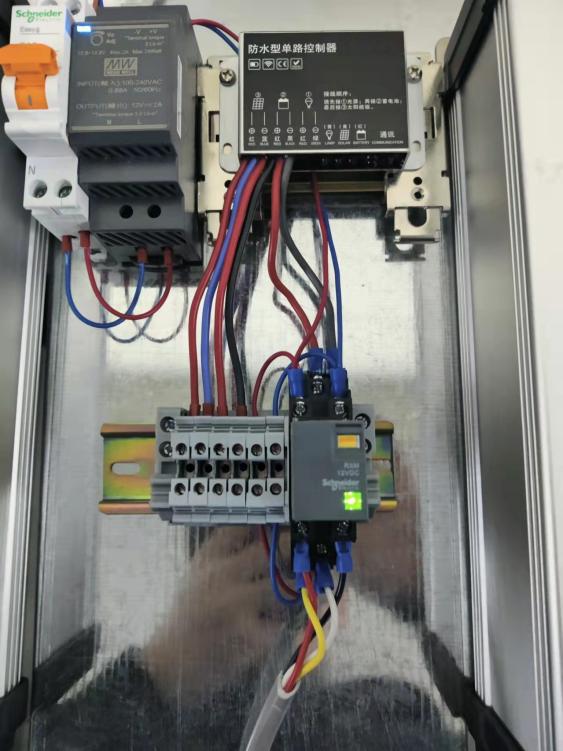
| Model | KJT-KNWLAT2R |
| Protocol standards | LoRa private network protocol |
| Frequency Range | 470~510MHz LoRa |
| Maximum link budget | 169dB |
| Maximum link budget | 27dBm |
| Polarization mode | Single polarization; vertical polarization |
Transmission rate Receive sensitivity (dBm) 2400bps -126dBm Sensitivity 800bps -130dBm 300bps -142dBm |
| Networking method | star |
| Recommended transmission distance | 20-1000M |
| Manage |
| Management style | Supports Chinese/English management, configuration without restarting; supports cloud management |
|
|
Reset | hardware | support |
| software | support |
| Function |
| Operating mode | P2P-S, M2P, etc. |
| Enter configuration | Support RS485 serial port, Ethernet interface |
| Protocol | MODBUS |
| signal light | Two-color waterproof signal light |
| Safety |
| Wireless encryption | CPC check AES128 |
| Hardware |
| CPU | Industrial grade MCU |
| Memory | FLASH | 32MB |
| SRAM | 2M |
| Expansion card (optional) | support |
| Main frequency | 400MHz |
1. Equipment installation
(1) The equipment is installed in a 304 stainless steel rainproof power supply box, and the antenna is installed first before powering on;
(2) Connect the PWR quick connector and press the ON/OFF power button;
(3) The STA green light flashes quickly and then slowly, indicating normal operation. The red light flashes when the wireless relay link is interrupted;
(4) The wireless repeater is paired and installed with the wireless pull-cord switch and the wireless host. The pairing process has been completed by default before leaving the factory. The device ID is affixed to the surface of the product and installed according to the corresponding point table;
2. Pairing point table
| Wireless cord switch | Wireless repeater | Wireless host |
| 1 | ID1~ID16 |
| ID1 |
| 2 | ID17~ID48 | ID2/ID3 |
|
| 3 | ID49~ID76 | ID4/ID5 |
|
| 4 | ID77~ID98 | ID6/ID7 |
|
| 5 | ID77~ID98 |
| ID8 |
Relay link table
| wireless host | wireless repeater | wireless repeater | wireless repeater | wireless host | wireless host |
| ID1 | ID2/ID3 | ID4/ID5 | ID6/ID7 | ID8 | ID9 |
Power supply instructions
(1) The repeater is powered by on-site power supply and solar battery.
(2) The on-site power supply is mainly powered, and it will automatically switch to solar power after the on-site power is cut off.
(3) The battery can also provide 200 hours of power even when there is no sunlight.
(4) The power switching modules have been connected and installed before leaving the factory.
(5) The air switch is the main switch
(6) The relay light is on for on-site power supply, and off for solar power supply.
(7) When solar power is supplied at that time, the device reports the current power supply method and power status.
(8) The intelligent gateway is connected to the host computer through a network cable for data transmission, and the transmission protocol is MODBUS TCP.

| Interface |
Connector | Number of sockets | 3 |
| Connector properties | 1-way waterproof DC interface, 1-way waterproof RJ45 interface, 1-way waterproof RS485 interface |
Antenna |
Antenna interface | N-type female connector 1 channel transmitting, 1 channel receiving (default) |
| N-type female connector 1 channel relay, 1 channel 4G (optional) |
| Antenna gain | 3dBi |
| Antenna angle | Vertically polarized omnidirectional antenna |
| powered by |
| Power supply mode | DC10V-30V recommended 12Vor24V |
| Work environment and characteristics |
| Surge protection | Common mode 4Kv/differential mode 2Kv |
| Humidity (non-condensing) | ≤95% (non-condensing) |
| Operating temperature | -40~75℃ |
| Storage temperature | -40~80℃ |
Characteristic | Number of uplink receive channels | 2 channels (supports 2 channels of parallel reception) |
| Number of downlink launch lanes | 1 channel |
| Number of trunk channels | 1 channel |
| Size | L*W*H(mm) | 250*200*75 |
Working current | Full load operating current | < 1.5A @12V |
| Normal working current | < 600mA @12V |
| Idle state operating current | <70mA @12V |










































